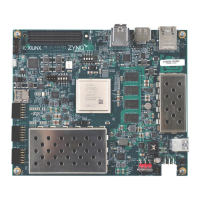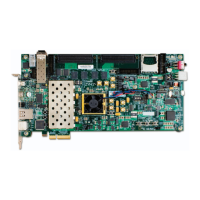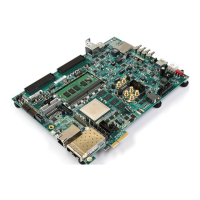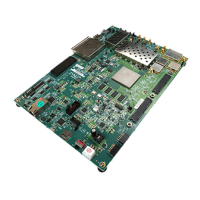Zynq-7000 PCB Design Guide www.xilinx.com 41
UG933 (v1.8) November 7, 2014
Chapter 4: SelectIO Signaling
Some I/O standards have attributes to control drive strength and slew rate, as well as the
presence of weak pull-up or pull-down and weak-keeper circuits (not intended for use as
parallel termination). Drive strength and slew rate can be used to tune an interface for
adequate speed while not overdriving the signals. Weak pull-ups, weak pull-downs, and
weak keepers can be used to ensure a known or steady level on a floating or 3-stated signal.
The “SelectIO Resources” chapter of UG471
, 7 Series FPGAs SelectIO Resources User Guide
describes which standards support these attributes. Refer to this user guide for more
information.
LVCMOS, when set to 6 mA DRIVE and FAST slew, has an approximate output impedance
close to 50Ω , allowing it to be used as a crude approximation of a controlled-impedance
driver. The impedance match of the weak driver to the transmission line is only approximate
and varies with voltage and temperature.
Input Thresholds
The input circuitry of the single-ended standards fall into two categories: those with fixed
input thresholds and those with input thresholds set by the V
REF
voltage. The use of V
REF
has three advantages:
• It allows for tighter control of input threshold levels
• It removes dependence on die GND for the threshold reference
• It allows for input thresholds to be closer together, which reduces the need for a large
voltage swing of the signal at the input receiver
Two 1.8V I/O standards that illustrate this are LVCMOS18 and SSTL18 Class 1. The
thresholds for 1.8V LVCMOS are set at 0.63V and 1.17V (necessitating that the signal at the
receiver swing a full 540 mV at minimum to make a logic transition). The thresholds for
SSTL18 Class 1 are set at V
REF
– 0.125V and V
REF
+ 0.125V, or for a nominal V
REF
of 0.9V, set
at 0.775V and 1.025V (necessitating that the signal at the receiver only swing 250 mV at
minimum to make a logic transition). This smaller required swing allows for higher
frequency of operation in the overall link. A smaller swing at the driver means reduced DC
power is required with less transient current. A historical drawback to the use of V
REF
was
that the semi-dedicated V
REF
pins of the bank could not be used as I/Os whenever an I/O
standard was used in a bank that required the V
REF
supply. However, with the 7 series
devices, the reference voltage can either be provided using the semi-dedicated V
REF
pins, or
optionally generated internally using the Internal V
REF
feature. See UG471, 7Series FPGAs
SelectIO User Guide for more details on Internal V
REF
. For more information on V
REF
decoupling and decoupling of all other supplies, see Chapter 3, Power Distribution System.
Topographies and Termination
Topography generally refers to the arrangement of drivers, receivers, interconnect and
terminations in an interface. The techniques used in unidirectional topographies are
different from those used in bidirectional topographies, so these are treated separately.

